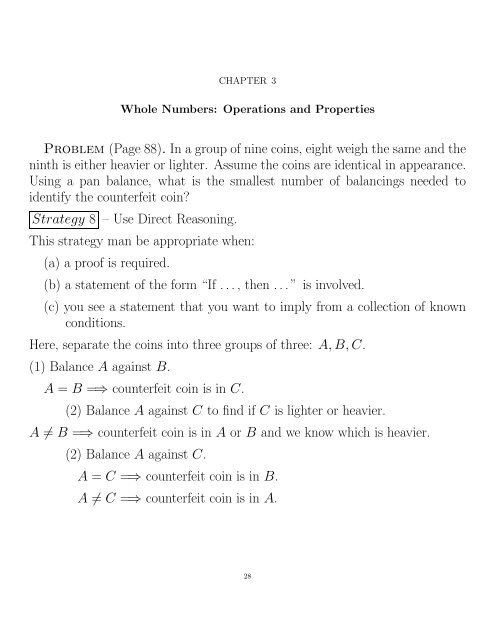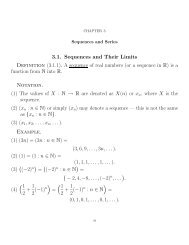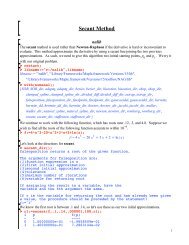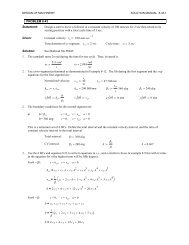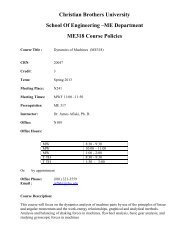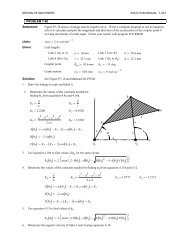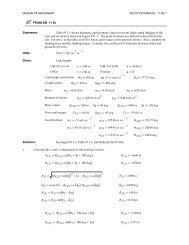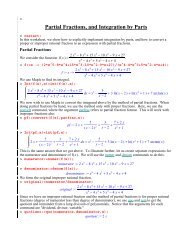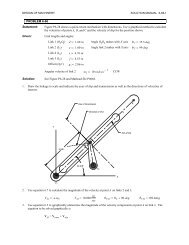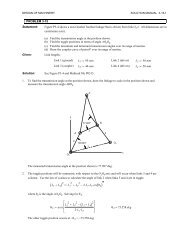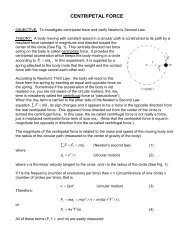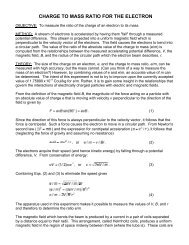Problem (Page 88). In a group of nine coins, eight weigh the same ...
Problem (Page 88). In a group of nine coins, eight weigh the same ...
Problem (Page 88). In a group of nine coins, eight weigh the same ...
Create successful ePaper yourself
Turn your PDF publications into a flip-book with our unique Google optimized e-Paper software.
CHAPTER 3Whole Numbers: Operations and Properties<strong>Problem</strong> (<strong>Page</strong> <strong>88</strong>). <strong>In</strong> a <strong>group</strong> <strong>of</strong> <strong>nine</strong> <strong>coins</strong>, <strong>eight</strong> <strong>weigh</strong> <strong>the</strong> <strong>same</strong> and <strong>the</strong>ninth is ei<strong>the</strong>r heavier or lighter. Assume <strong>the</strong> <strong>coins</strong> are identical in appearance.Using a pan balance, what is <strong>the</strong> smallest number <strong>of</strong> balancings needed toidentify <strong>the</strong> counterfeit coin?Strategy 8 – Use Direct Reasoning.This strategy man be appropriate when:(a) a pro<strong>of</strong> is required.(b) a statement <strong>of</strong> <strong>the</strong> form “If . . . , <strong>the</strong>n . . . ” is involved.(c) you see a statement that you want to imply from a collection <strong>of</strong> knownconditions.Here, separate <strong>the</strong> <strong>coins</strong> into three <strong>group</strong>s <strong>of</strong> three: A, B, C.(1) Balance A against B.A = B =) counterfeit coin is in C.(2) Balance A against C to find if C is lighter or heavier.A 6= B =) counterfeit coin is in A or B and we know which is heavier.(2) Balance A against C.A = C =) counterfeit coin is in B.A 6= C =) counterfeit coin is in A.28
3.1. ADDITION AND SUBTRACTION 29Name <strong>the</strong> three <strong>coins</strong> in <strong>the</strong> chosen <strong>group</strong> a, b, c.(3) Balance a against b.a = b =) counterfeit coin is c.a 6= b and chosen <strong>group</strong> heavier =) counterfeit coin is heavier <strong>of</strong> a and b.a 6= b and chosen <strong>group</strong> lighter =) counterfeit coin is lighter <strong>of</strong> a and b.Two models <strong>of</strong> addition:3.1. Addition and Subtraction(1) The set model – uses <strong>the</strong> union <strong>of</strong> disjoint sets.Definition (Addition <strong>of</strong> Whole Numbers). Let A and B be any two wholenumbers. If A and B are disjoint sets with a = n(A) and b = n(B), <strong>the</strong>na + b = n(A [ B).“a” and “b” are called addends or summands.Addition is called a binary operation since two numbers are combined to producea unique number.
30 3. WHOLE NUMBERS: OPERATIONS AND PROPERTIES(2) The measurement model – uses directed arrows on a number line.Properties <strong>of</strong> whole number addition:Closure propertyThe sum <strong>of</strong> any two whole numbers is a whole number.Example. The even whole numbers are closed under addition.The odd whole numbers are not closed under addition. Why?Commutative propertyLet a and b be any whole numbers. Then a + b = b + a.Associative propertyLet a, b, and c be any whole numbers. Then(a + b) + c = a + (b + c).
3.1. ADDITION AND SUBTRACTION 31Identity propertyThere is a unique whole number, namely 0, such that for all whole numbers a,a + 0 = a = 0 + a.The number 0 is called <strong>the</strong> additive identity or <strong>the</strong> identity for addition.Thinking strategies for learning <strong>the</strong> addition facts:There are 100 places to be filled in <strong>the</strong> following table. We illustrate 4 + 1 = 5.
32 3. WHOLE NUMBERS: OPERATIONS AND PROPERTIES(1) Commutativity – once <strong>the</strong> lower left <strong>of</strong> <strong>the</strong> table is completer, <strong>the</strong> upperright is obtained by commutativity.(2) Adding zero –using a + 0 = a fills <strong>the</strong> leftmost column.(3) Counting on by 1 and 2 – e.g., for 7 + 1, 7 + 2, think 7, 8, 9. This gives <strong>the</strong>next two columns.
3.1. ADDITION AND SUBTRACTION 33(4) Combinations to 10 – using fingers, 7 + 3, 6 + 4, 5 + 5, etc. all equal 10.(5) Adding doubles –down <strong>the</strong> main diagonal, 1 + 1 = 2, 2 + 2 = 4, 3 + 3 = 6,etc., or counting by two’s: 2, 4, 6, 8, . . .The pattern for <strong>the</strong> remaining numbers is clear, or just use (6) - (8) below.(6) Adding 10 – 4 + 10 = 14, 8 + 10 = 18, etc. Pretty clear(7) Associativity –9 + 7 = 10 + 6 = 16 since 9 + 7 = 9 + (1 + 6) = (9 + 1) + 6 = 10 + 68 + 5 = 10 + 3 = 13 since 8 + 5 = 8 + (2 + 3) = (8 + 2) + 3 = 10 + 3(8) Doubles ±1 and ±2 –8 + 9 = 8 + 8 + 1 = 16 + 1 = 178 + 7 = 8 + 8 1 = 16 1 = 15
34 3. WHOLE NUMBERS: OPERATIONS AND PROPERTIES7 + 9 = 7 + 7 + 2 = 14 + 2 = 168 + 6 = 8 + 8 2 = 16 2 = 14<strong>Problem</strong> (<strong>Page</strong> 101 # 8).Subtraction – two approaches:(1) The take-away approach –The set model:(2) The measurement model:
3.1. ADDITION AND SUBTRACTION 35Definition (Subtraction – Take-Away Approach).Let a and b be any whole numbers and A and B be sets such that a = n(A),b = n(B), and B ✓ A. Thena b = n(A B).“a b” is <strong>the</strong> di↵erence <strong>of</strong> a and b, “a” is <strong>the</strong> minuend, and “b” is <strong>the</strong> subtrahend.Subtraction – <strong>the</strong> missing addend approachDefinition (Subtraction - Missing Addend Approach).Let a and b be any whole numbers. Then a b = c if and only if ( () )a = b + c for some whole number c.This approach is useful for learning subtraction facts by relating <strong>the</strong>m to additionfacts via four-fact families:
36 3. WHOLE NUMBERS: OPERATIONS AND PROPERTIESMany subtraction facts can be obtained from an addition facts table.Example (A Two Set, Comparison Model, Using Matching). If Larry has$7 and Judy has $3, how much more money does Larry have?7 3 = 4After matching, we can use ei<strong>the</strong>r <strong>the</strong> take-away or <strong>the</strong> missing addend approach.Note. Subtraction is not closed, for 3 5 does not have a whole number asan answer. What about <strong>the</strong> o<strong>the</strong>r properties we have for addition?Example (Four fact family in base 5).3 5 + 4 5 =12 54 5 + 3 5 =12 512 5 3 5 =4 512 5 4 5 =3 5
Approaches to Multiplication(1) Repeated addition approach3.2. MULTIPLICATION AND DIVISION 373.2. Multiplication and Division3 + 3 + 3 + 3 + 3 = 15 or 5 ⇥ 3 = 15Definition (Multiplication – Repeated Addition Approach).Let a and b be any whole numbers where a 6= 0. Thenab = b | + b + {z· · · + } b .a addendsIf a = 1, <strong>the</strong>n ab = 1 · b = b; also 0 · b = 0 for all b.a and b are called factors, and ab is called <strong>the</strong> product.
38 3. WHOLE NUMBERS: OPERATIONS AND PROPERTIES(2) Rectangular array approach3 + 3 + 3 + 3 + 3 = 15 or 5 ⇥ 3 = 15Definition (Multipication - Rectangular Array Approach).Let a and b be any whole numbers. Then ab is <strong>the</strong> number <strong>of</strong> elements in arectangular array having a rows and b columns.(3) Cartesian Product Approach2 ⇥ 3 = 6Definition (Multipication - Cartesian Product Approach).Let a and b be any whole numbers. If a = n(A) and b = n(B) for some sets Aand B,ab = n(A ⇥ B).
3.2. MULTIPLICATION AND DIVISION 39An alternative version <strong>of</strong> (3) is:(4) Tree Diagram Approach2 ⇥ 3 = 6Properties <strong>of</strong> Whole Number Multiplication:(1) Closure PropertyThe product <strong>of</strong> two whole numbers is a whole number.Example. The set <strong>of</strong> odd whole numbers and <strong>the</strong> set <strong>of</strong> even whole numbersare both closed under multiplication, but <strong>the</strong> setis not closed since 3 · 8 /2 A.Commutative PropertyA = {3, 8, 13, 18, 23, 28, . . . }Let a and b be any whole numbers. Thenab = ba.
40 3. WHOLE NUMBERS: OPERATIONS AND PROPERTIES(3) Associative PropertyLet a, b, and c be any whole numbers. Thena(bc) = (ab)c.(4) Identity PropertyThe number 1 is <strong>the</strong> unique whole number such that for every whole numbera,a · 1 = a = 1 · a.1 is called <strong>the</strong> multiplicative identity or <strong>the</strong> identity for multiplication.(5) Distributive Property <strong>of</strong> Multiplication over AdditionLet a, b, and c be any whole numbers. Thena(b + c) = ab + ac.The 3 is distributed to <strong>the</strong> 2 and <strong>the</strong> 4.Note. This property relates <strong>the</strong> operations <strong>of</strong> addition and multiplication.
3.2. MULTIPLICATION AND DIVISION 41(6) Distributive Property <strong>of</strong> Multiplication over AdditionLet a, b, and c be any whole numbers. Then, provided b c,a(b c) = ab ac.Pro<strong>of</strong>.Let b c = n.Then b = c + n (Missing addend).ab = a(c + n).ab = ac + an (distributive)Thus ab ac = an (missing addend)But b c = n.So ab ac = a(b c). ⇤Multiplication Property <strong>of</strong> ZeroFor every whole number a,a · 0 = 0 · a = 0.
42 3. WHOLE NUMBERS: OPERATIONS AND PROPERTIESThinking Strategies for Learning Multiplication Facts:(1) Commutativity –just as with addition, once we find 55 facts, <strong>the</strong> o<strong>the</strong>rs areobtained by commutativity.(2) Multiplication by 0 – since a · 0 = 0, <strong>the</strong> first column is all 0’s.(3) Multiplication by 1 – since a · 1 = a, <strong>the</strong> second column is identical to <strong>the</strong>left-hand column.(4) Multiplication by 2 – since a · 2 = a + a, <strong>the</strong> third column is doubles fromaddition.(5) Multiplication by 5 – use counting chant by 5’s : 5, 10, 15, etc.(6) Multiplication by 9 – ten’s digit is one less than number we are multiplyingby 9, and <strong>the</strong> sum <strong>of</strong> <strong>the</strong> digits is 9.9 ⇥ 1 = 9, 9 ⇥ 2 = 18, 9 ⇥ 3 = 27, . . .
3.2. MULTIPLICATION AND DIVISION 43(7) Associativity and Distributivity –Example.8 ⇥ 6 = 8(3 + 3) = 8 · 3 + 8 · 3 = 24 + 24 = 487 ⇥ 4 = 7(2 ⇥ 2) = (7 ⇥ 2) ⇥ 2 = 14 ⇥ 2 = 28<strong>Problem</strong> (<strong>Page</strong> 118 # 11a).
44 3. WHOLE NUMBERS: OPERATIONS AND PROPERTIESDivision – two conceptual ways <strong>of</strong> viewing:Sharing (partative) division – breaking a <strong>group</strong> <strong>of</strong> objects into a specified number<strong>of</strong> <strong>group</strong>s (at <strong>the</strong> beginning, <strong>the</strong> number <strong>of</strong> <strong>group</strong>s is known, but <strong>the</strong> <strong>group</strong>size isn’t).Measurement division – breaking a <strong>group</strong> <strong>of</strong> objects into a number <strong>of</strong> <strong>group</strong>s<strong>of</strong> a specified size (at <strong>the</strong> beginning, <strong>the</strong> size <strong>of</strong> each <strong>group</strong> is known, but <strong>the</strong>number <strong>of</strong> <strong>group</strong>s isn’t)Missing factor approachDefinition.If a and b are any whole numbers with b 6= 0, <strong>the</strong>n a ÷ b = c if and only ifa = bc for some whole number c.a is called <strong>the</strong> dividend, b is called <strong>the</strong> divisor, and c is called <strong>the</strong> quotient.
3.2. MULTIPLICATION AND DIVISION 45This is based on ano<strong>the</strong>r four-fact family:Division Property <strong>of</strong> zeroIf a 6= 0, <strong>the</strong>n 0 ÷ a = 0.What about dividing by 0?(1) If a 6= 0 and a ÷ 0 = c, <strong>the</strong>n a = 0 · c = 0, a contradiction.(2) If 0 ÷ 0 = c, <strong>the</strong>n 0 = 0 · c for any whole number c, so <strong>the</strong>re is no uniquequotient. Thus division by 0 is undefined.Division with Remainder – having some objects left over.Theorem – a statement that can be proved based on o<strong>the</strong>r results.Theorem (Division Algorithm). If a and b are any whole numbers withb 6= 0, <strong>the</strong>n <strong>the</strong>ir exist unique whole numbers q and r such thata = bq + r where 0 apple r < b.a is <strong>the</strong> dividend, b <strong>the</strong> divisor, q <strong>the</strong> quotient, and r <strong>the</strong> remainder.
46 3. WHOLE NUMBERS: OPERATIONS AND PROPERTIESAlternative ways <strong>of</strong> viewing <strong>the</strong> repeated-subtraction approach.<strong>Problem</strong> (<strong>Page</strong> 118 # 11b).i) 61 8 ÷ 7 8 = 7 8ii) 17 8 ÷ 3 8 = 5 8iii) 30 8 ÷ 6 8 = 4 8iv) 16 8 ÷ 2 8 = 7 8v) 44 8 ÷ 6 8 = 6 8vi) 25 8 ÷ 7 8 = 3 83.3. Ordering and ExponentsOrdering and Whole Number OperationsDefinition (“Less Than” for Whole Numbers).For any two whole numbers a and b, a < b (or b > a) if and only if <strong>the</strong>re is anonzero whole number n such that a + n = b.apple means less than or equal to.means greater than or equal to.
3.3. ORDERING AND EXPONENTS 47Transitive Property <strong>of</strong> Less Than for Whole NumbersFor all whole numbers a, b, and c, if a < b and b < c, <strong>the</strong>n a < c.Pro<strong>of</strong>.a < b =) a + n = b for some whole nonzero whole number n.b < c =) b + m = c for some whole nonzero whole number m.Then (a + n) + m = b + m =) a + (n + m) = b + m =) a + (n + m) = c,and n + m is a nonzero whole number, so a < c.⇤Note. The transitive property also holds if >,, or apple are used throughout.Less Than and Addition for Whole NumbersIf a < b, <strong>the</strong>n a + c < b + c.Less Than and Multiplication for Whole NumbersIf a < b and c 6= 0, <strong>the</strong>n ac < bc.
48 3. WHOLE NUMBERS: OPERATIONS AND PROPERTIESExponents – used to simplify multiplication expressions.Definition (Whole Number Exponent).Let a and m be any whole numbers where m 6= 0. Thena m = a · a · · · a | {z }m factorsm is <strong>the</strong> exponent or power <strong>of</strong> a, and a is called <strong>the</strong> base.Example.Theorem.3 5 · 3 3 = (3 · 3 · 3 · 3 · 3) · (3 · 3 · 3) = 3 8Let a, m, and n be any whole numbers where m and n are nonzero. ThenPro<strong>of</strong>.a m · a n = a · a · · · a | {z }m factorsa m · a n = a m+n .· a · a · · · a | {z }n factors= a · a · · · a | {z }m + n factors= a m+n ⇤Example.3 3 · 5 3 = (3 · 3 · 3) = (5 · 5 · 5) = (3 · 5) · (3 · 5) · (3 · 5) = (3 · 5) 3Theorem.Let a, b, and m be any whole numbers where m 6= 0. ThenPro<strong>of</strong>.a m · b m = a · a · · · a | {z }m factorsa m · b m = (ab) m .· b · b · · · b | {z }m factors= (ab) · (ab) · · · (ab)| {z }m factors= (ab) m ⇤
Example.Theorem.3.3. ORDERING AND EXPONENTS 49(4 2 ) 3 = 4 2 · 4 2 · 4 2 = 4 6Let a, m, and n be any whole numbers where m and n are nonzero. ThenThusExample.Theorem.(a m ) n = a mn .6 8 ÷ 6 3 = 6 5 since 6 3 · 6 5 = 6 8 .6 8 ÷ 6 3 = 6 8 3 .Let a, m, and n be any whole numbers where m > n and a, m, and n arenonzero. Thena m ÷ a n = a m n .0 as an exponentFor a 6= 0, consider <strong>the</strong> pattern:a 3 = a · a · aDivide each side by a.a 2 = a · aDivide each side by a.a 1 = aDivide each side by a.a 0 = 1Definition. a 0 = 1 for all whole numbers a 6= 0.
50 3. WHOLE NUMBERS: OPERATIONS AND PROPERTIESConsider <strong>the</strong> two following patterns:Pattern 1: 3 0 = 1, 2 0 = 1, 1 0 = 1, 0 0 = ?Pattern 2: 0 3 = 0, 0 2 = 0, 0 1 = 0, 0 0 = ?Each pattern suggests a di↵erent answer to 0 0 , so:Note. 0 0 is not defined.Order <strong>of</strong> Operations – an agreementExample.11 2 2 ÷ 2 · 5 + (7 (6 2)) =(1) Paren<strong>the</strong>ses (from inside out)11 2 2 ÷ 2 · 5 + (7 4) =11 2 2 ÷ 2 · 5 + 3 =(2) Exponents in order from left to right11 4 ÷ 2 · 5 + 3 =(3) Multiplications and divisions in order from left to right11 2 · 5 + 3 =11 10 + 3 =(4) Additions and subtractions in order fro left to rightNote.1 + 3 =(1) “Please Excuse My Dear Aunt Sally” is a useful pneunomic.(2) Most calculators (including those used at CBU) follow <strong>the</strong>se rules.4


